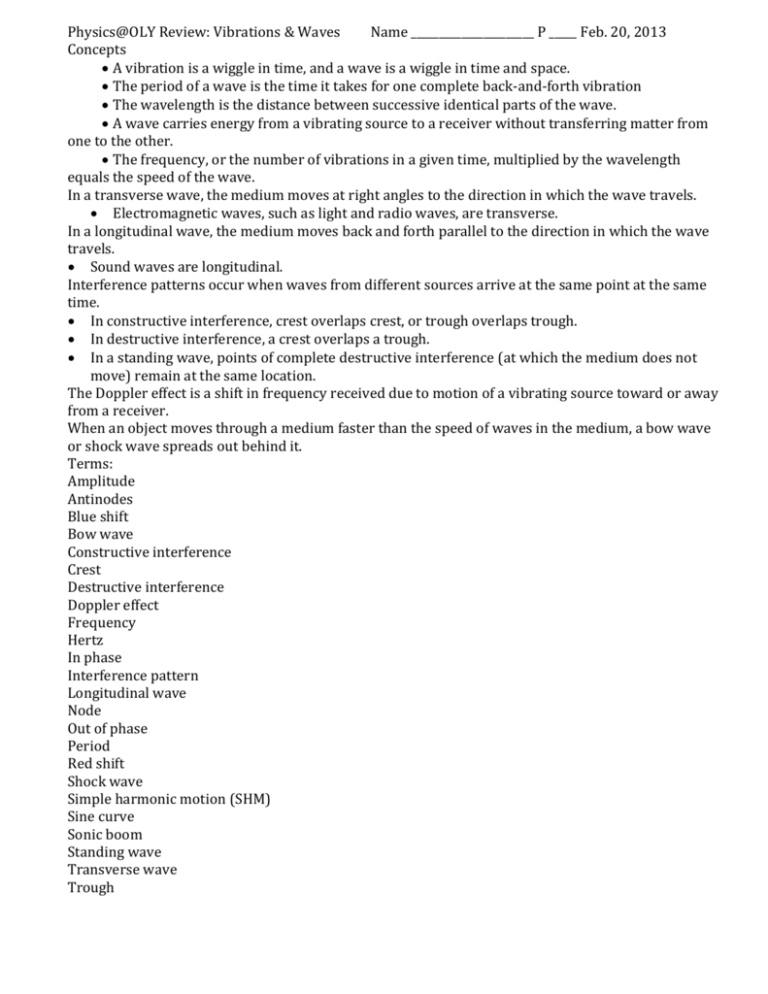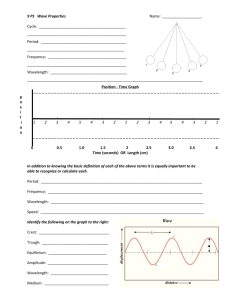Physics@OLY Review: Vibrations & Waves Name P _____ Feb. 20
advertisement

Physics@OLY Review: Vibrations & Waves Name ______________________ P _____ Feb. 20, 2013 Concepts A vibration is a wiggle in time, and a wave is a wiggle in time and space. The period of a wave is the time it takes for one complete back-and-forth vibration The wavelength is the distance between successive identical parts of the wave. A wave carries energy from a vibrating source to a receiver without transferring matter from one to the other. The frequency, or the number of vibrations in a given time, multiplied by the wavelength equals the speed of the wave. In a transverse wave, the medium moves at right angles to the direction in which the wave travels. Electromagnetic waves, such as light and radio waves, are transverse. In a longitudinal wave, the medium moves back and forth parallel to the direction in which the wave travels. Sound waves are longitudinal. Interference patterns occur when waves from different sources arrive at the same point at the same time. In constructive interference, crest overlaps crest, or trough overlaps trough. In destructive interference, a crest overlaps a trough. In a standing wave, points of complete destructive interference (at which the medium does not move) remain at the same location. The Doppler effect is a shift in frequency received due to motion of a vibrating source toward or away from a receiver. When an object moves through a medium faster than the speed of waves in the medium, a bow wave or shock wave spreads out behind it. Terms: Amplitude Antinodes Blue shift Bow wave Constructive interference Crest Destructive interference Doppler effect Frequency Hertz In phase Interference pattern Longitudinal wave Node Out of phase Period Red shift Shock wave Simple harmonic motion (SHM) Sine curve Sonic boom Standing wave Transverse wave Trough Vibration Wave Wavelength Problems 1. A nurse counts 76 heartbeats in one minute. What are the period_____ and frequency of the heartbeats? _______ 2. NY’s 300-m high Citicorp Tower oscillates in the wind with a period of 6.80 s. f= __________ 3. Calculate the speed of waves in a puddle that are 0.15 m apart and made by tapping the water surface twice each second. _________ 4. Calculate the speed of waves in water that are 0.4 m apart and have a f of 2 Hz._____ 5. The lowest f that we can hear is 20 Hz. Calc. the wavelength if the speed of sound is 340 m/s. ___ Think & Explain 1. Red light has a longer wavelength than violet light. Which has the greatest f?_____ 2. If you triple the f of a vibrating object, what would happen to the period? _____ 6. Astronomers find that light coming from point A at the edge of the Sun has a slightly higher f than light from point B at the opposite side. What do these measurements tell us about the sun’s motion? _____ 8. Why does the sound from an overhead airplane seem to come from behind it?___________ 9. The faster the speed of a supersonic airplane the conic shock wave becomes ____________ 10. Why is it that a subsonic aircraft, no matter how loud it may be, cannot produce a sonic boom? ____






